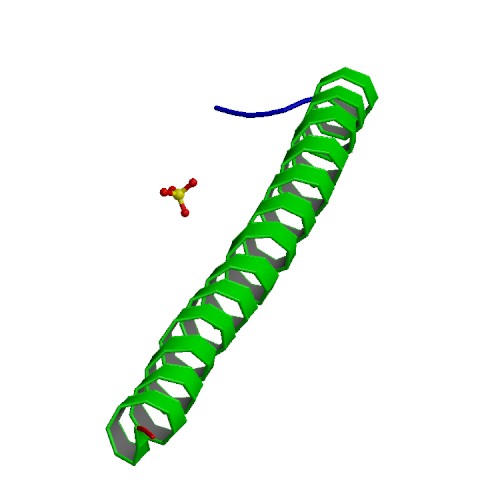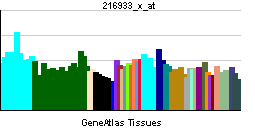APC (gene)
| Adenomatosis polyposis coli | |||||||||||
|---|---|---|---|---|---|---|---|---|---|---|---|
 PDB rendering based on 1deb. | |||||||||||
| Identifiers | |||||||||||
| Symbols | APC ; DP2; DP2.5; DP3; FAP; FPC; GS | ||||||||||
| External IDs | Template:OMIM5 Template:MGI HomoloGene: 30950 | ||||||||||
| |||||||||||
| RNA expression pattern | |||||||||||
 | |||||||||||
| More reference expression data | |||||||||||
| Orthologs | |||||||||||
| Template:GNF Ortholog box | |||||||||||
| Species | Human | Mouse | |||||||||
| Entrez | n/a | n/a | |||||||||
| Ensembl | n/a | n/a | |||||||||
| UniProt | n/a | n/a | |||||||||
| RefSeq (mRNA) | n/a | n/a | |||||||||
| RefSeq (protein) | n/a | n/a | |||||||||
| Location (UCSC) | n/a | n/a | |||||||||
| PubMed search | n/a | n/a | |||||||||
|
WikiDoc Resources for APC (gene) |
|
Articles |
|---|
|
Most recent articles on APC (gene) |
|
Media |
|
Evidence Based Medicine |
|
Clinical Trials |
|
Ongoing Trials on APC (gene) at Clinical Trials.gov Clinical Trials on APC (gene) at Google
|
|
Guidelines / Policies / Govt |
|
US National Guidelines Clearinghouse on APC (gene)
|
|
Books |
|
News |
|
Commentary |
|
Definitions |
|
Patient Resources / Community |
|
Patient resources on APC (gene) Discussion groups on APC (gene) Patient Handouts on APC (gene) Directions to Hospitals Treating APC (gene) Risk calculators and risk factors for APC (gene)
|
|
Healthcare Provider Resources |
|
Causes & Risk Factors for APC (gene) |
|
Continuing Medical Education (CME) |
|
International |
|
|
|
Business |
|
Experimental / Informatics |
Overview
APC (adenomatosis polyposis coli) is a human gene that is classified as a tumor suppressor gene. Tumor suppressor genes prevent the uncontrolled growth of cells that may result in cancerous tumors. The protein made by the APC gene plays a critical role in several cellular processes that determine whether a cell may develop into a tumor. The APC protein helps control how often a cell divides, how it attaches to other cells within a tissue, or whether a cell moves within or away from a tissue. This protein also helps ensure that the chromosome number in cells produced through cell division is correct. The APC protein accomplishes these tasks mainly through association with other proteins, especially those that are involved in cell attachment and signaling. The activity of one protein in particular, beta-catenin, is controlled by the APC protein (see: Wnt signaling pathway). Regulation of beta-catenin prevents genes that stimulate cell division from being turned on too often and prevents cell overgrowth.
The APC gene is located on the long (q) arm of chromosome 5 between positions 21 and 22, from base pair 112,118,468 to base pair 112,209,532.
Related conditions
Familial adenomatous polyposis (FAP) is caused by mutations in the APC gene. More than 800 mutations in the APC gene have been identified in families with classic and attenuated types of familial adenomatous polyposis. Most of these mutations cause the production of an APC protein that is abnormally short and nonfunctional. This short protein cannot suppress the cellular overgrowth that leads to the formation of polyps, which can become cancerous. The most common mutation in familial adenomatous polyposis is a deletion of five bases (the building blocks of DNA) in the APC gene. This mutation changes the sequence of amino acids (the building material of proteins) in the resulting APC protein beginning at position 1309.
Another mutation is carried by approximately 6 percent of people of Ashkenazi (eastern and central European) Jewish heritage. This mutation results in the substitution of the amino acid lysine for isoleucine at position 1307 in the APC protein (also written as I1307K or Ile1307Lys). This change was initially thought to be harmless, but has recently been shown to be associated with a 10 to 20 percent increased risk of colon cancer.
Regulation of Proliferation
The (Adenomatosis Polyposis Coli) APC protein normally builds a complex with glycogensynthasekinase 3beta(GSK 3β) and Axin. This complex is then able to bind β- catenins in the cytoplasm, that have dissociated from adherens contacts between cells. After binding, APC facilitates the lysis of this molecule through proteolytic enzymes. This prevents it from translocating into the nucleus, where it acts as a transcription factor for proliferation genes. The deactivation of the APC protein can take place after certain chain reactions in the cytoplasm are started, e.g. through the Wnt signals that destroy the conformation of the complex. In the nucleus it complexes with legless/BCL9, TCF, and Pygo and begins function of an RNA polymerase but for oncogenes.
Further reading
- Cohen MM Jr (2003). "Molecular dimensions of gastrointestinal tumors: some thoughts for digestion". Am J Med Genet A. 122 (4): 303–14. PMID 14518068
- Fearnhead NS, Britton MP, Bodmer WF (2001). "The ABC of APC". Hum Mol Genet. 10 (7): 721–33. PMID 11257105
- Fodde R (2002). "The APC gene in colorectal cancer". Eur J Cancer. 38 (7): 867–71. PMID 11978510
- Goss KH, Groden J (2000). "Biology of the adenomatous polyposis coli tumor suppressor". J Clin Oncol. 18 (9): 1967–79. PMID 10784639
- Jarvinen HJ, Peltomaki P (2004). "The complex genotype-phenotype relationship in familial adenomatous polyposis". Eur J Gastroenterol Hepatol. 16 (1): 5–8. PMID 15095846
- Lal G, Gallinger S (2000). "Familial adenomatous polyposis". Semin Surg Oncol. 18 (4): 314–23. PMID 10805953
- van Es JH, Giles RH, Clevers HC (2001). "The many faces of the tumor suppressor gene APC". Exp Cell Res. 264 (1): 126–34. PMID 11237529
External links
- Adenomatous+Polyposis+Coli+Protein at the US National Library of Medicine Medical Subject Headings (MeSH)
- GeneCard